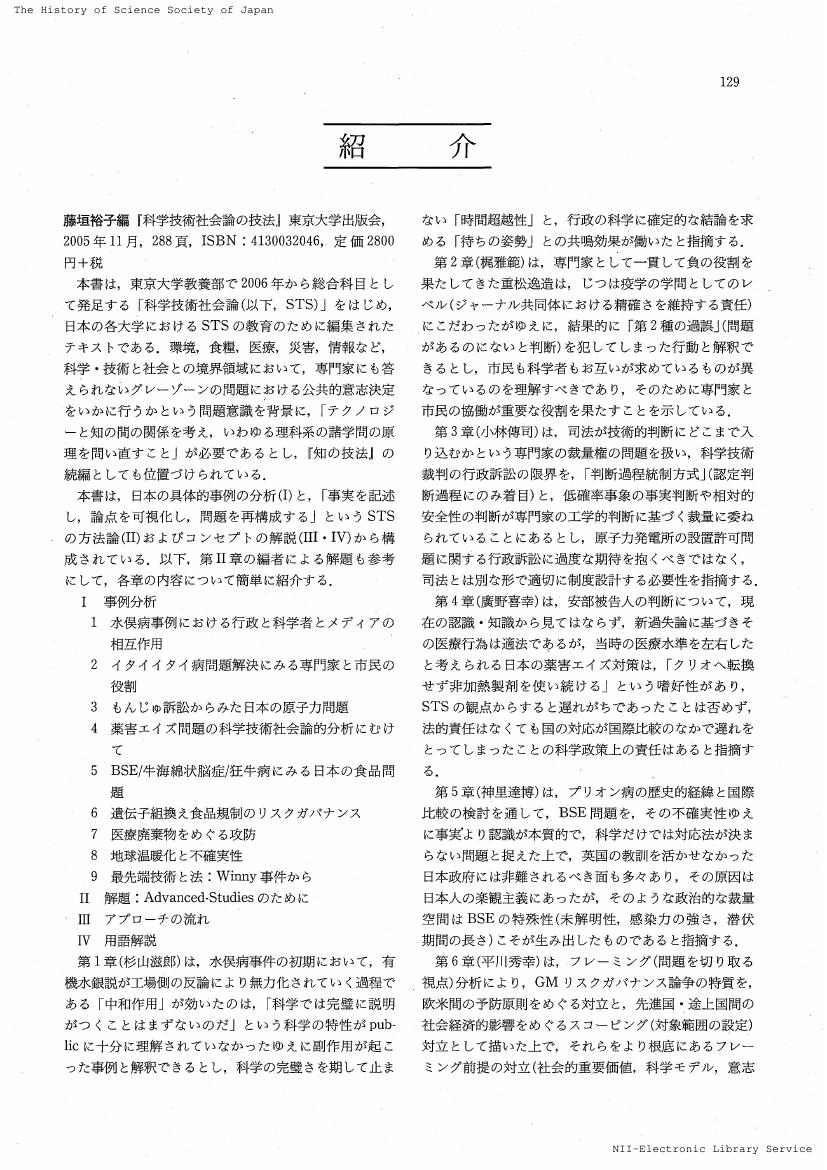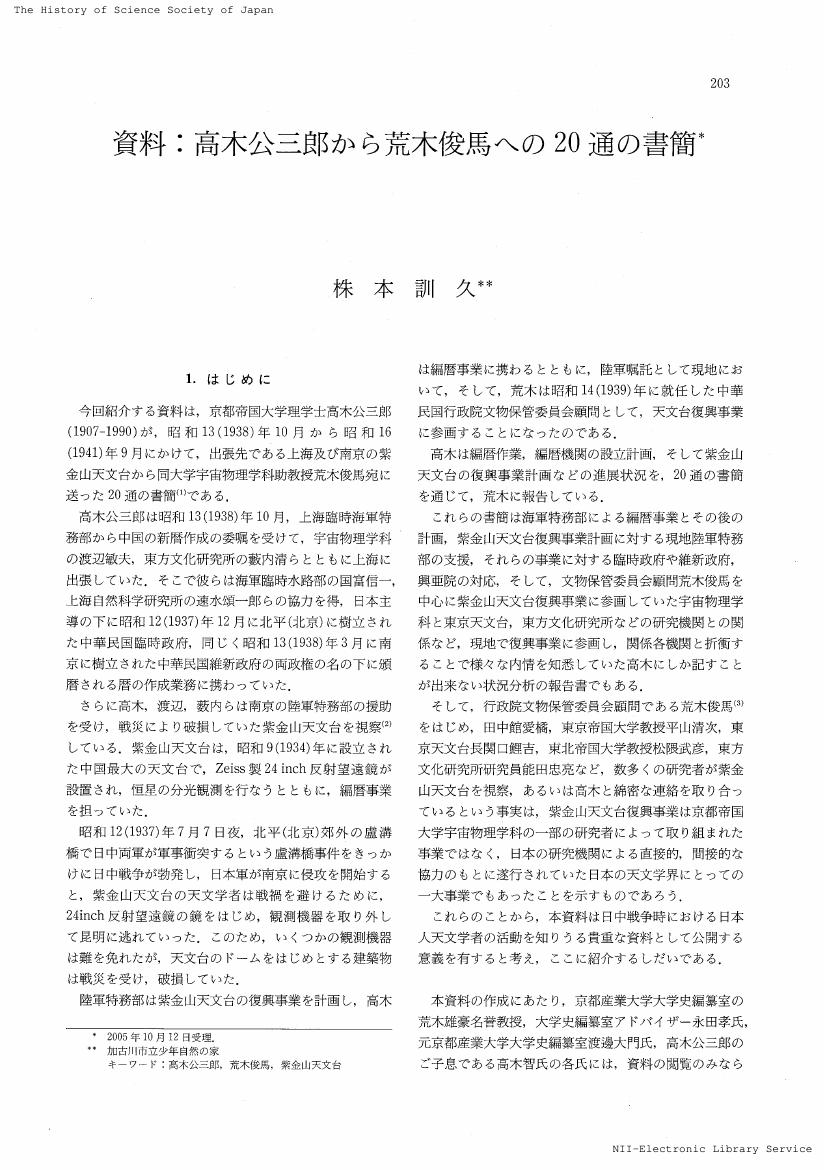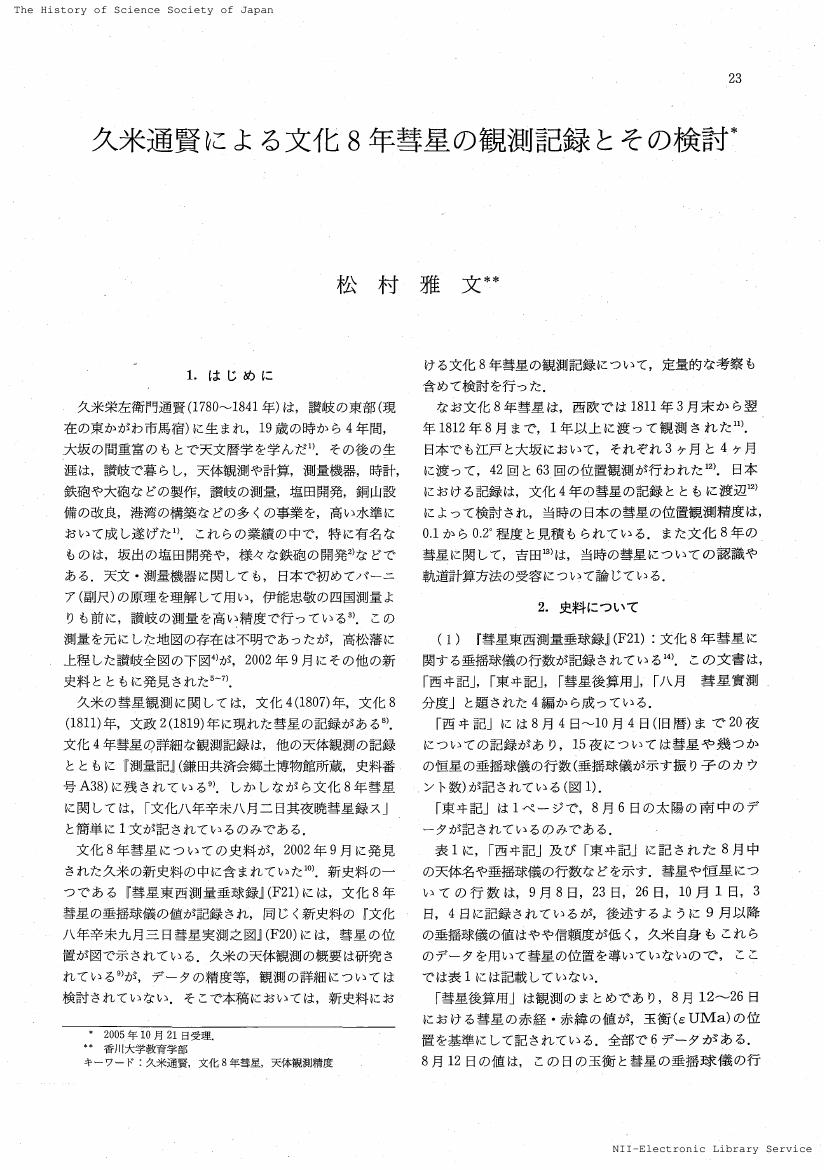1 0 0 0 OA 技術の内的発展法則論と歴史の法則性(アゴラ)
- 著者
- 山崎 正勝
- 出版者
- 日本科学史学会
- 雑誌
- 科学史研究 (ISSN:21887535)
- 巻号頁・発行日
- vol.45, no.238, pp.103-104, 2006 (Released:2021-08-11)
1 0 0 0 OA 第22回国際科学史会議での日本からの報告(続)
1 0 0 0 OA 紹介
- 出版者
- 日本科学史学会
- 雑誌
- 科学史研究 (ISSN:21887535)
- 巻号頁・発行日
- vol.45, no.238, pp.129, 2006 (Released:2021-08-11)
1 0 0 0 OA ソヴィエトの語法を身につけた物理学者 : 1930年代哲学論争とその帰結
- 著者
- 金山 浩司
- 出版者
- 日本科学史学会
- 雑誌
- 科学史研究 (ISSN:21887535)
- 巻号頁・発行日
- vol.45, no.239, pp.145-156, 2006 (Released:2021-08-11)
In this paper, I examine the reason for the subsidence of Soviet dispute over philosophical legitimation of modern physics in the late 1930s. The battle of scientists against party ideologues or their sympathizers was politically adventurous in the period of the Great Terror. In fact, established scientists such as Nikolai Vavilov were severely accused by opponents and were led even to be imprisoned. However, in spite of the heated attack to some leading physicists in the dispute over modern physics in philosophical journals, the worst tragedy was avoided in general. I maintain that Sergei Vavilov, one of the most influential physicists of this period, acted as a crucial negotiator in this process. By learning the Marxist terminology or a politically correct attitude in the discourse, Vavilov succeeded in soothing the party ideologues and at the same time guarding modern physics or physicists. In some respect he made a compromise, but it was a very valuable one.
- 著者
- 荒尾 美代
- 出版者
- 日本科学史学会
- 雑誌
- 科学史研究 (ISSN:21887535)
- 巻号頁・発行日
- vol.45, no.239, pp.157-161, 2006 (Released:2021-08-11)
1 0 0 0 OA 経済学における技術の諸理論と環境問題の分析に関する一試論
- 著者
- 氏川 憲次
- 出版者
- 日本科学史学会
- 雑誌
- 科学史研究 (ISSN:21887535)
- 巻号頁・発行日
- vol.45, no.239, pp.162-165, 2006 (Released:2021-08-11)
1 0 0 0 OA 絶縁ゲート型電界効果トランジスタ研究について(日本科学史学会第53回年会記念講演)
- 著者
- 菅野 卓雄
- 出版者
- 日本科学史学会
- 雑誌
- 科学史研究 (ISSN:21887535)
- 巻号頁・発行日
- vol.45, no.239, pp.166-172, 2006 (Released:2021-08-11)
1 0 0 0 OA 宗教と殺生観(科学史入門)
- 著者
- 中村 禎里
- 出版者
- 日本科学史学会
- 雑誌
- 科学史研究 (ISSN:21887535)
- 巻号頁・発行日
- vol.45, no.237, pp.38-41, 2006 (Released:2021-08-11)
1 0 0 0 OA シンポジウム:世界から見た日本の炭鉱技術 : 炭鉱保存と技術の継承
1 0 0 0 OA 第22回国際科学史会議での日本からの報告
1 0 0 0 OA 来日学者の講演と開会式から見た1953年国際理論物理学会・京都&東京(アゴラ)
- 著者
- 溝畑 典宏
- 出版者
- 日本科学史学会
- 雑誌
- 科学史研究 (ISSN:21887535)
- 巻号頁・発行日
- vol.45, no.237, pp.70-72, 2006 (Released:2021-08-11)
- 被引用文献数
- 1
1 0 0 0 OA ロックフェラー財団による184インチのサイクロトロン計画への援助決定過程
- 著者
- 日野川 静枝
- 出版者
- 日本科学史学会
- 雑誌
- 科学史研究 (ISSN:21887535)
- 巻号頁・発行日
- vol.45, no.238, pp.81-91, 2006 (Released:2021-08-11)
The World War II broke out in Europe in 1939, and the United States set up the National Defense Research Committee on June in 1940. On April 3,1940, the Meeting of Trustees of the Rockefeller Foundation decided on a grant of $1,150,000 to support the construction of a new 184-inch cyclotron at the University of California. This paper elucidates the process leading up to that decision. The decision-making process can be divided into three stages : The first, beginning in October 1939, saw initial enthusiasm for the giant cyclotron project; the second, lasting until February 1940, involved changes in the Foundation's internal circumstances and limitations on funding; the third, which began in early February 1940, saw specific steps toward the materialization of Foundation support for the project. Doubtlessly, Lawrence's supporters tangibly and intangibly influenced the Rockefeller Foundation's decision to support the construction of the giant cyclotron. The decision-making process, however, seems to shed light on the Foundation's grant-making plans or grant-making policy. That is, the Foundation was deeply involved in drawing up the plans from the start, and provided grants for carefully-selected, large-scale, and long-range projects in the fields it was interested in. The giant cyclotron project, for which single-source support was an important issue, seems to be one such case.
1 0 0 0 OA 梅文鼎著『中西算學通』と清華大学図書館の暦算書
- 著者
- 小林 龍彦
- 出版者
- 日本科学史学会
- 雑誌
- 科学史研究 (ISSN:21887535)
- 巻号頁・発行日
- vol.45, no.238, pp.92-95, 2006 (Released:2021-08-11)
1 0 0 0 OA 戦時中のウラン探鉱
- 著者
- 矢島 道子
- 出版者
- 日本科学史学会
- 雑誌
- 科学史研究 (ISSN:21887535)
- 巻号頁・発行日
- vol.45, no.238, pp.96-98, 2006 (Released:2021-08-11)
1 0 0 0 OA 高木公三郎から荒木俊馬への20通の書簡
- 著者
- 株本 訓久
- 出版者
- 日本科学史学会
- 雑誌
- 科学史研究 (ISSN:21887535)
- 巻号頁・発行日
- vol.44, no.236, pp.203-224, 2005 (Released:2021-08-11)
1 0 0 0 OA 紹介
- 出版者
- 日本科学史学会
- 雑誌
- 科学史研究 (ISSN:21887535)
- 巻号頁・発行日
- vol.44, no.236, pp.232-237, 2005 (Released:2021-08-11)
- 著者
- 今井 正浩
- 出版者
- 日本科学史学会
- 雑誌
- 科学史研究 (ISSN:21887535)
- 巻号頁・発行日
- vol.45, no.237, pp.11-22, 2006 (Released:2021-08-11)
The Hippocratic treatise De Natura Hominis (On the Nature of Man) has been very influential in the history of western medical thought from antiquity, because it argues the theory of four humors as the essential constituents of human body. There has been a traditional view on the theory among scholars that the author Polybos referred to Empedocles' philosophical doctrine of four elements as a model in the formation of the humoral physiology of his own. However, the theory of four humors, as compared with the doctrine of four elements, turns out to be different on the following points. 1) The four elements are introduced as substantial entities, which always remain self-identical, whereas the four humors change into one another, according to the degree of the four elemental qualities (Hot and Cold, Humid and Dry), which constitute their own nature. 2) In the Empedoclean doctrine, human nature comes into being emergently from the four elements, when they come together, or when they separate out of their primordial lump. In NH, the generation process seems to be dependent on human nature, which exists as the determinant of the conditions under which the generation can take place. 3) The Empedoclean cosmic cycle functions as a structural framework, within which the generation takes place. The cosmic system in NH has its own purpose of giving a causal explanation about how the four humors increase and decrease reciprocally in the human body, according to the alternation of the four seasons. These results will make us suppose that the philosophical influences of Empedocles on the theory of four humors remained within a very limited scope, although there are traces in some phrases and sentences as well as forms of argumentation in NH, which may be judged to be reflection of the Empedoclean philosophical poems.
1 0 0 0 OA 久米通賢による文化8年彗星の観測記録とその検討
- 著者
- 松村 雅文
- 出版者
- 日本科学史学会
- 雑誌
- 科学史研究 (ISSN:21887535)
- 巻号頁・発行日
- vol.45, no.237, pp.23-28, 2006 (Released:2021-08-11)
1 0 0 0 OA 岩橋嘉孝の『平天儀』
- 著者
- 海野 一隆
- 出版者
- 日本科学史学会
- 雑誌
- 科学史研究 (ISSN:21887535)
- 巻号頁・発行日
- vol.45, no.237, pp.29-33, 2006 (Released:2021-08-11)
1 0 0 0 OA サイクロトロン開発の各国比較 : 巨大科学の起源を探る(科学史入門)
- 著者
- 日野川 静枝
- 出版者
- 日本科学史学会
- 雑誌
- 科学史研究 (ISSN:21887535)
- 巻号頁・発行日
- vol.45, no.237, pp.34-37, 2006 (Released:2021-08-11)
















